2005 CHEVROLET SILVERADO check oil
[x] Cancel search: check oilPage 536 of 580
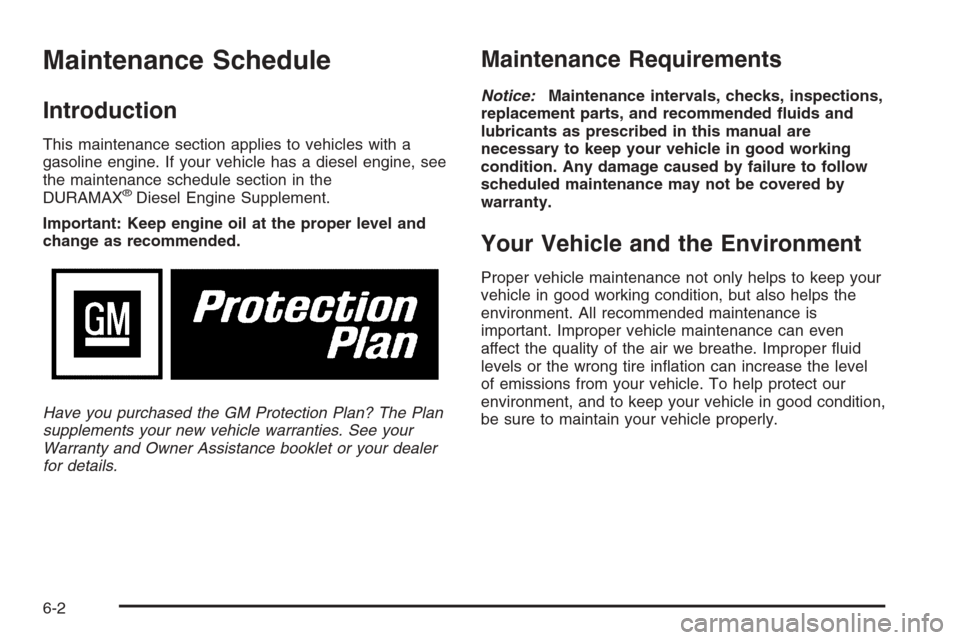
Maintenance Schedule
Introduction
This maintenance section applies to vehicles with a
gasoline engine. If your vehicle has a diesel engine, see
the maintenance schedule section in the
DURAMAX
®Diesel Engine Supplement.
Important: Keep engine oil at the proper level and
change as recommended.
Have you purchased the GM Protection Plan? The Plan
supplements your new vehicle warranties. See your
Warranty and Owner Assistance booklet or your dealer
for details.
Maintenance Requirements
Notice:Maintenance intervals, checks, inspections,
replacement parts, and recommended �uids and
lubricants as prescribed in this manual are
necessary to keep your vehicle in good working
condition. Any damage caused by failure to follow
scheduled maintenance may not be covered by
warranty.
Your Vehicle and the Environment
Proper vehicle maintenance not only helps to keep your
vehicle in good working condition, but also helps the
environment. All recommended maintenance is
important. Improper vehicle maintenance can even
affect the quality of the air we breathe. Improper �uid
levels or the wrong tire in�ation can increase the level
of emissions from your vehicle. To help protect our
environment, and to keep your vehicle in good condition,
be sure to maintain your vehicle properly.
6-2
Page 538 of 580
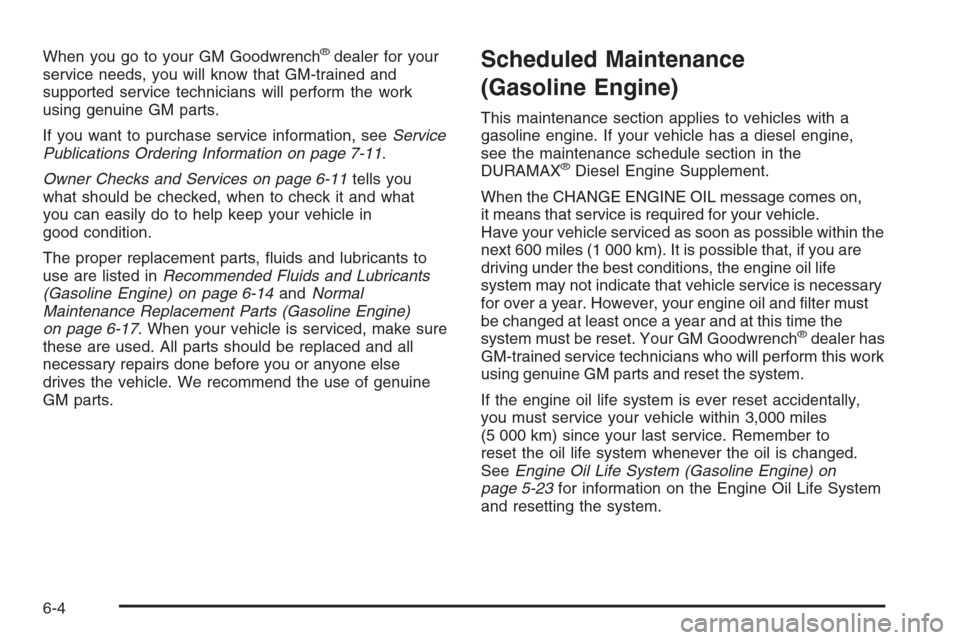
When you go to your GM Goodwrench®dealer for your
service needs, you will know that GM-trained and
supported service technicians will perform the work
using genuine GM parts.
If you want to purchase service information, seeService
Publications Ordering Information on page 7-11.
Owner Checks and Services on page 6-11tells you
what should be checked, when to check it and what
you can easily do to help keep your vehicle in
good condition.
The proper replacement parts, �uids and lubricants to
use are listed inRecommended Fluids and Lubricants
(Gasoline Engine) on page 6-14andNormal
Maintenance Replacement Parts (Gasoline Engine)
on page 6-17. When your vehicle is serviced, make sure
these are used. All parts should be replaced and all
necessary repairs done before you or anyone else
drives the vehicle. We recommend the use of genuine
GM parts.Scheduled Maintenance
(Gasoline Engine)
This maintenance section applies to vehicles with a
gasoline engine. If your vehicle has a diesel engine,
see the maintenance schedule section in the
DURAMAX
®Diesel Engine Supplement.
When the CHANGE ENGINE OIL message comes on,
it means that service is required for your vehicle.
Have your vehicle serviced as soon as possible within the
next 600 miles (1 000 km). It is possible that, if you are
driving under the best conditions, the engine oil life
system may not indicate that vehicle service is necessary
for over a year. However, your engine oil and �lter must
be changed at least once a year and at this time the
system must be reset. Your GM Goodwrench
®dealer has
GM-trained service technicians who will perform this work
using genuine GM parts and reset the system.
If the engine oil life system is ever reset accidentally,
you must service your vehicle within 3,000 miles
(5 000 km) since your last service. Remember to
reset the oil life system whenever the oil is changed.
SeeEngine Oil Life System (Gasoline Engine) on
page 5-23for information on the Engine Oil Life System
and resetting the system.
6-4
Page 539 of 580
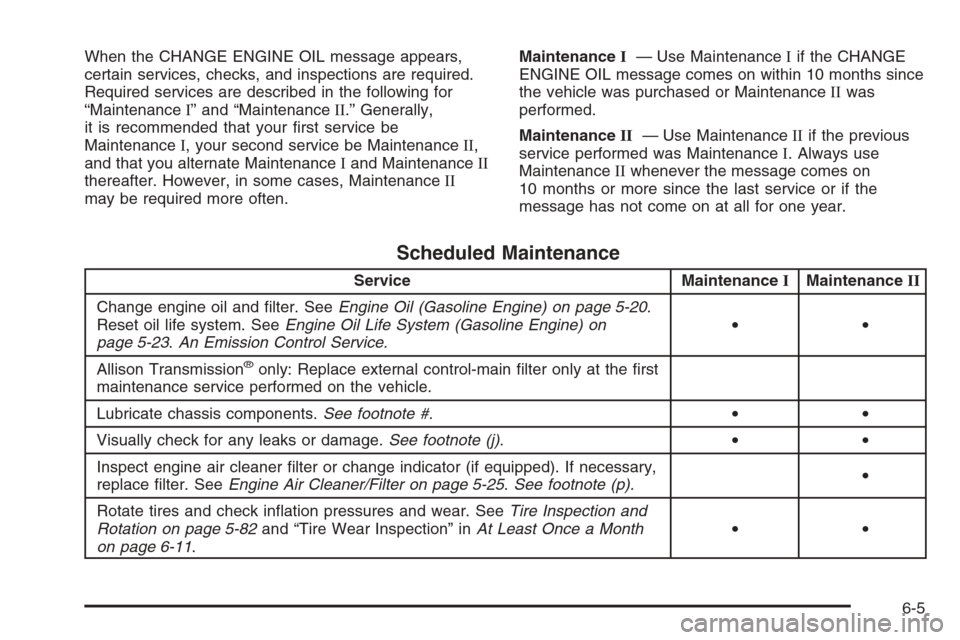
When the CHANGE ENGINE OIL message appears,
certain services, checks, and inspections are required.
Required services are described in the following for
“MaintenanceI” and “MaintenanceII.” Generally,
it is recommended that your �rst service be
MaintenanceI, your second service be MaintenanceII,
and that you alternate MaintenanceIand MaintenanceII
thereafter. However, in some cases, MaintenanceII
may be required more often.MaintenanceI— Use MaintenanceIif the CHANGE
ENGINE OIL message comes on within 10 months since
the vehicle was purchased or MaintenanceIIwas
performed.
MaintenanceII— Use MaintenanceIIif the previous
service performed was MaintenanceI. Always use
MaintenanceIIwhenever the message comes on
10 months or more since the last service or if the
message has not come on at all for one year.
Scheduled Maintenance
Service MaintenanceIMaintenanceII
Change engine oil and �lter. SeeEngine Oil (Gasoline Engine) on page 5-20.
Reset oil life system. SeeEngine Oil Life System (Gasoline Engine) on
page 5-23.An Emission Control Service.••
Allison Transmission
®only: Replace external control-main �lter only at the �rst
maintenance service performed on the vehicle.
Lubricate chassis components.See footnote #.••
Visually check for any leaks or damage.See footnote (j).••
Inspect engine air cleaner �lter or change indicator (if equipped). If necessary,
replace �lter. SeeEngine Air Cleaner/Filter on page 5-25.See footnote (p).•
Rotate tires and check in�ation pressures and wear. SeeTire Inspection and
Rotation on page 5-82and “Tire Wear Inspection” inAt Least Once a Month
on page 6-11.••
6-5
Page 544 of 580
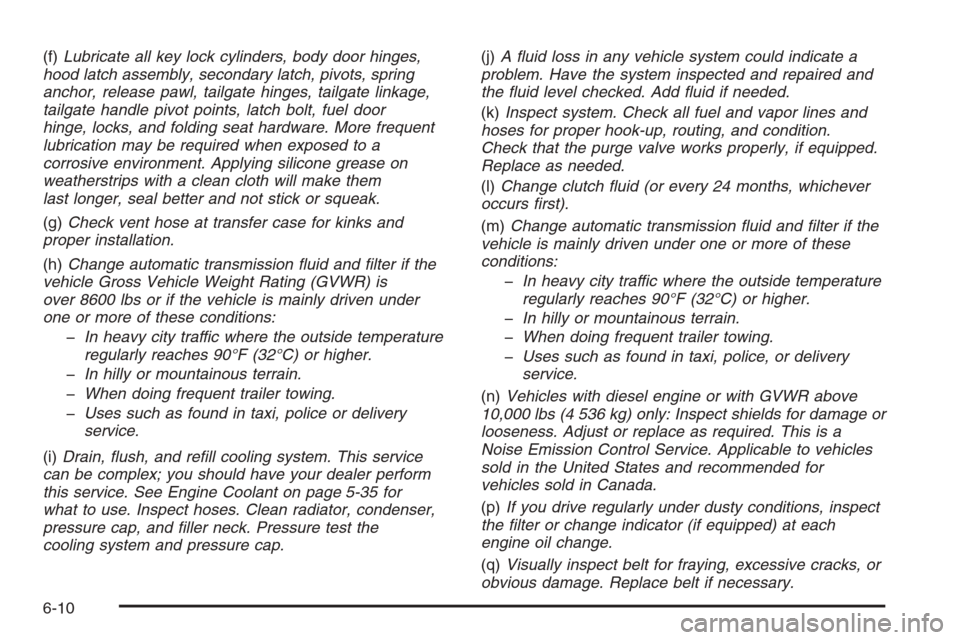
(f)Lubricate all key lock cylinders, body door hinges,
hood latch assembly, secondary latch, pivots, spring
anchor, release pawl, tailgate hinges, tailgate linkage,
tailgate handle pivot points, latch bolt, fuel door
hinge, locks, and folding seat hardware. More frequent
lubrication may be required when exposed to a
corrosive environment. Applying silicone grease on
weatherstrips with a clean cloth will make them
last longer, seal better and not stick or squeak.
(g)Check vent hose at transfer case for kinks and
proper installation.
(h)Change automatic transmission �uid and �lter if the
vehicle Gross Vehicle Weight Rating (GVWR) is
over 8600 lbs or if the vehicle is mainly driven under
one or more of these conditions:
�In heavy city traffic where the outside temperature
regularly reaches 90°F (32°C) or higher.
�In hilly or mountainous terrain.
�When doing frequent trailer towing.
�Uses such as found in taxi, police or delivery
service.
(i)Drain, �ush, and re�ll cooling system. This service
can be complex; you should have your dealer perform
this service. See Engine Coolant on page 5-35 for
what to use. Inspect hoses. Clean radiator, condenser,
pressure cap, and �ller neck. Pressure test the
cooling system and pressure cap.(j)A �uid loss in any vehicle system could indicate a
problem. Have the system inspected and repaired and
the �uid level checked. Add �uid if needed.
(k)Inspect system. Check all fuel and vapor lines and
hoses for proper hook-up, routing, and condition.
Check that the purge valve works properly, if equipped.
Replace as needed.
(l)Change clutch �uid (or every 24 months, whichever
occurs �rst).
(m)Change automatic transmission �uid and �lter if the
vehicle is mainly driven under one or more of these
conditions:
�In heavy city traffic where the outside temperature
regularly reaches 90°F (32°C) or higher.
�In hilly or mountainous terrain.
�When doing frequent trailer towing.
�Uses such as found in taxi, police, or delivery
service.
(n)Vehicles with diesel engine or with GVWR above
10,000 lbs (4 536 kg) only: Inspect shields for damage or
looseness. Adjust or replace as required. This is a
Noise Emission Control Service. Applicable to vehicles
sold in the United States and recommended for
vehicles sold in Canada.
(p)If you drive regularly under dusty conditions, inspect
the �lter or change indicator (if equipped) at each
engine oil change.
(q)Visually inspect belt for fraying, excessive cracks, or
obvious damage. Replace belt if necessary.
6-10
Page 545 of 580
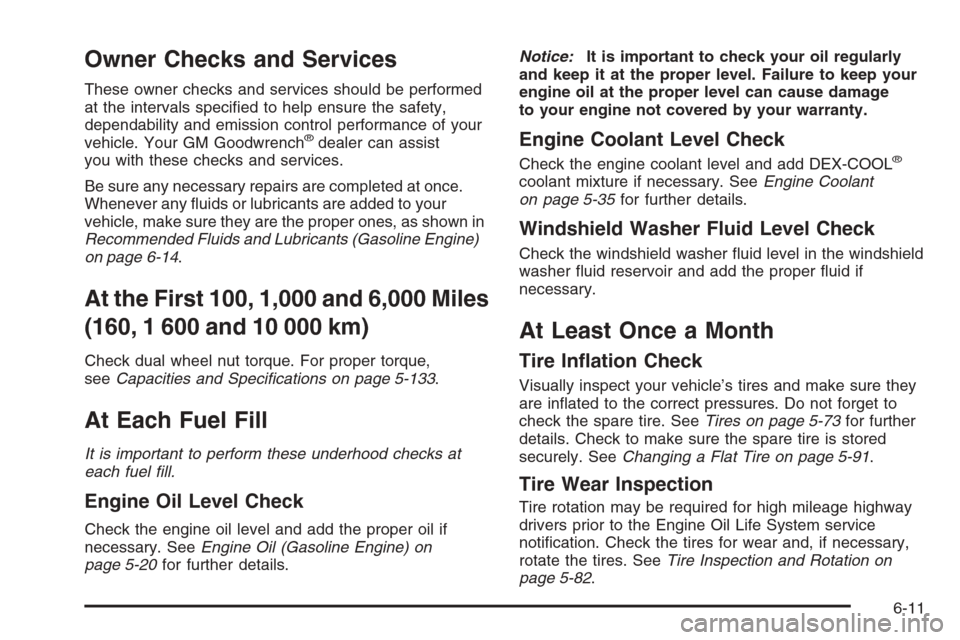
Owner Checks and Services
These owner checks and services should be performed
at the intervals speci�ed to help ensure the safety,
dependability and emission control performance of your
vehicle. Your GM Goodwrench
®dealer can assist
you with these checks and services.
Be sure any necessary repairs are completed at once.
Whenever any �uids or lubricants are added to your
vehicle, make sure they are the proper ones, as shown in
Recommended Fluids and Lubricants (Gasoline Engine)
on page 6-14.
At the First 100, 1,000 and 6,000 Miles
(160, 1 600 and 10 000 km)
Check dual wheel nut torque. For proper torque,
seeCapacities and Speci�cations on page 5-133.
At Each Fuel Fill
It is important to perform these underhood checks at
each fuel �ll.
Engine Oil Level Check
Check the engine oil level and add the proper oil if
necessary. SeeEngine Oil (Gasoline Engine) on
page 5-20for further details.Notice:It is important to check your oil regularly
and keep it at the proper level. Failure to keep your
engine oil at the proper level can cause damage
to your engine not covered by your warranty.
Engine Coolant Level Check
Check the engine coolant level and add DEX-COOL®
coolant mixture if necessary. SeeEngine Coolant
on page 5-35for further details.
Windshield Washer Fluid Level Check
Check the windshield washer �uid level in the windshield
washer �uid reservoir and add the proper �uid if
necessary.
At Least Once a Month
Tire In�ation Check
Visually inspect your vehicle’s tires and make sure they
are in�ated to the correct pressures. Do not forget to
check the spare tire. SeeTires on page 5-73for further
details. Check to make sure the spare tire is stored
securely. SeeChanging a Flat Tire on page 5-91.
Tire Wear Inspection
Tire rotation may be required for high mileage highway
drivers prior to the Engine Oil Life System service
noti�cation. Check the tires for wear and, if necessary,
rotate the tires. SeeTire Inspection and Rotation on
page 5-82.
6-11
Page 571 of 580
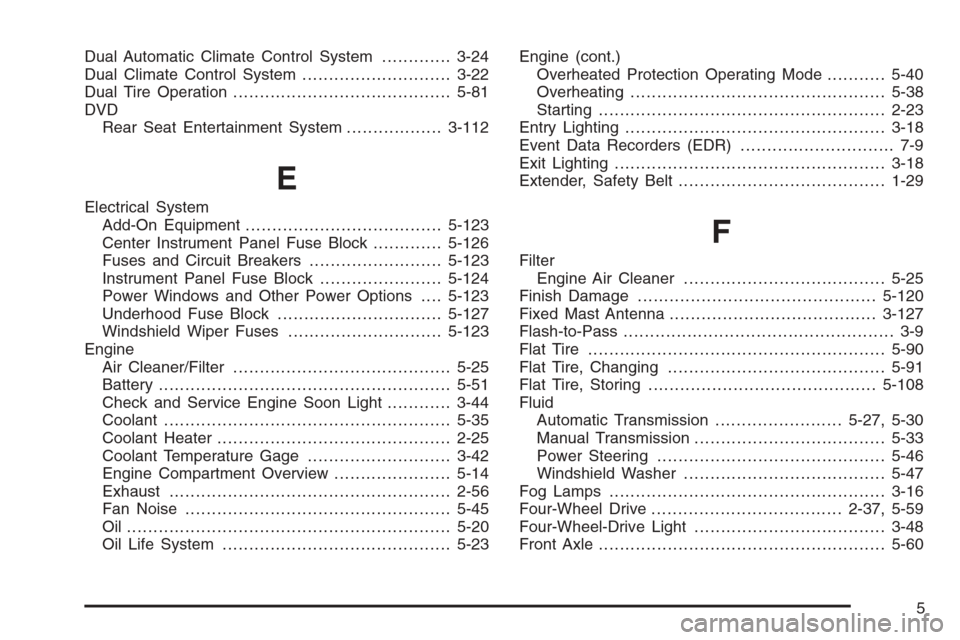
Dual Automatic Climate Control System.............3-24
Dual Climate Control System............................3-22
Dual Tire Operation.........................................5-81
DVD
Rear Seat Entertainment System..................3-112
E
Electrical System
Add-On Equipment.....................................5-123
Center Instrument Panel Fuse Block.............5-126
Fuses and Circuit Breakers.........................5-123
Instrument Panel Fuse Block.......................5-124
Power Windows and Other Power Options....5-123
Underhood Fuse Block...............................5-127
Windshield Wiper Fuses.............................5-123
Engine
Air Cleaner/Filter.........................................5-25
Battery.......................................................5-51
Check and Service Engine Soon Light............3-44
Coolant......................................................5-35
Coolant Heater............................................2-25
Coolant Temperature Gage...........................3-42
Engine Compartment Overview......................5-14
Exhaust.....................................................2-56
Fan Noise..................................................5-45
Oil .............................................................5-20
Oil Life System...........................................5-23Engine (cont.)
Overheated Protection Operating Mode...........5-40
Overheating................................................5-38
Starting......................................................2-23
Entry Lighting.................................................3-18
Event Data Recorders (EDR)............................. 7-9
Exit Lighting...................................................3-18
Extender, Safety Belt.......................................1-29
F
Filter
Engine Air Cleaner......................................5-25
Finish Damage.............................................5-120
Fixed Mast Antenna.......................................3-127
Flash-to-Pass................................................... 3-9
Flat Tire........................................................5-90
Flat Tire, Changing.........................................5-91
Flat Tire, Storing...........................................5-108
Fluid
Automatic Transmission........................5-27, 5-30
Manual Transmission....................................5-33
Power Steering...........................................5-46
Windshield Washer......................................5-47
Fog Lamps ....................................................3-16
Four-Wheel Drive....................................2-37, 5-59
Four-Wheel-Drive Light....................................3-48
Front Axle......................................................5-60
5
Page 575 of 580
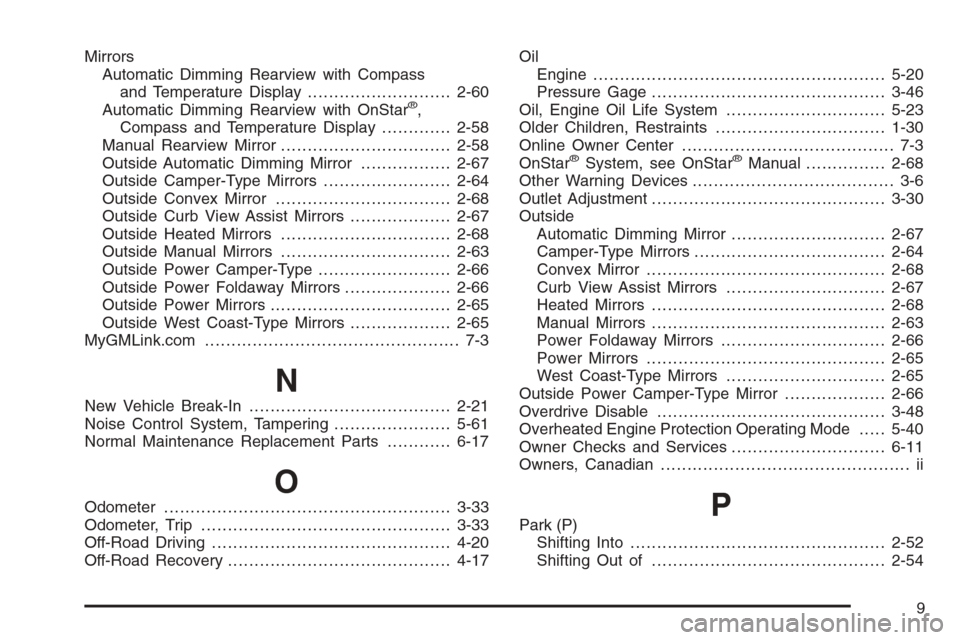
Mirrors
Automatic Dimming Rearview with Compass
and Temperature Display...........................2-60
Automatic Dimming Rearview with OnStar
®,
Compass and Temperature Display.............2-58
Manual Rearview Mirror................................2-58
Outside Automatic Dimming Mirror.................2-67
Outside Camper-Type Mirrors........................2-64
Outside Convex Mirror.................................2-68
Outside Curb View Assist Mirrors...................2-67
Outside Heated Mirrors................................2-68
Outside Manual Mirrors................................2-63
Outside Power Camper-Type.........................2-66
Outside Power Foldaway Mirrors....................2-66
Outside Power Mirrors..................................2-65
Outside West Coast-Type Mirrors...................2-65
MyGMLink.com................................................ 7-3
N
New Vehicle Break-In......................................2-21
Noise Control System, Tampering......................5-61
Normal Maintenance Replacement Parts............6-17
O
Odometer......................................................3-33
Odometer, Trip...............................................3-33
Off-Road Driving.............................................4-20
Off-Road Recovery..........................................4-17Oil
Engine.......................................................5-20
Pressure Gage............................................3-46
Oil, Engine Oil Life System..............................5-23
Older Children, Restraints................................1-30
Online Owner Center........................................ 7-3
OnStar
®System, see OnStar®Manual...............2-68
Other Warning Devices...................................... 3-6
Outlet Adjustment............................................3-30
Outside
Automatic Dimming Mirror.............................2-67
Camper-Type Mirrors....................................2-64
Convex Mirror.............................................2-68
Curb View Assist Mirrors..............................2-67
Heated Mirrors............................................2-68
Manual Mirrors............................................2-63
Power Foldaway Mirrors...............................2-66
Power Mirrors.............................................2-65
West Coast-Type Mirrors..............................2-65
Outside Power Camper-Type Mirror...................2-66
Overdrive Disable...........................................3-48
Overheated Engine Protection Operating Mode.....5-40
Owner Checks and Services.............................6-11
Owners, Canadian............................................... ii
PPark (P)
Shifting Into................................................2-52
Shifting Out of............................................2-54
9